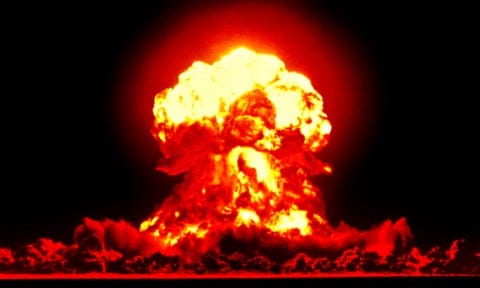Nuclear Deep Fakes
"Nuclear power’s deep fake was launched 75 years ago, quite deliberately, using public opinion manipulation tools that were primitive compared to those available today."
The image above is of the “Geiger Counter plant,” KU9 Spiderwort. I have been propagating this strain in my garden from the original clone I obtained from its creator in 1977. It has an uncommon tolerance to heat and cold, reappearing as a perennial despite extremes of minus 25°F in winter and 120°F in summer. This makes it especially well adapted to rapid climate change.
Tradescantia nonukes, var. Ichikawa (1977), also known as Tradescantia x 'KU9', was called "the most excellent test system ever known for low-level radiation" by Japanese geneticist Sadao Ichikawa, part of the team at Brookhaven National Laboratory on Long Island that developed this monitoring system in the late 1960s. Unlike its more common counterparts bred for the beauty of their flowers, this particular cultivar was bred to serve as a natural, biological Geiger counter.
'KU9' has segmented stems with grassy blades and produces blue, three-petaled flowers. When exposed to radiation, the blue cells of the single-cell strand stamen hairs turn pink. The increase in pink cells is proportional to the dose of radiation received, even at extremely low levels. Cell counts can be accurately correlated to Seiverts, a measure of the biological effect of radiation exposure. The KU9 is a hybrid of Tradescantia paludosa and Tradescantia ohiensis. The color change can be observed most efficiently about 12 or 13 days after radiation exposure.
Engineering Fakery
The Government Accountability Office had been asked by Senator Joe Manchin to investigate the vulnerability of the nation’s nuclear reactors to climate change. Manchin, a millionaire Senator whose fortune in West Virginia was built on exploiting the dirtiest form of coal, is neither a strong believer in climate change nor in the future of nuclear power. The subject, however, needed research—Manchin had that right—and as might be expected, the release of the GAO report stirred controversy, although perhaps less than is required.
When a company decides to shut down a nuclear power plant permanently, the facility must be decommissioned by safely removing it from service and reducing residual radioactivity to a level that permits release of the property and termination of the operating license. NRC regulates the decommissioning a nuclear power plant and any spent nuclear fuel that will remain on site.
Spent nuclear fuel is the fuel that has been removed from commercial nuclear power reactors after it has been used to produce electricity. Spent nuclear fuel is initially stored immersed in pools of water designed to cool and isolate it from the environment. Water circulates in the pools to remove the heat generated from the radioactive decay. Industry practice has been to store the spent nuclear fuel in these pools for at least 5 years or until the fuel has cooled enough to be transferred to dry cask storage. Dry cask storage consists of a steel canister that holds the fuel assemblies, protected by an outer cask made of steel and concrete designed to cool the fuel and provide shielding from its radiation.
—GAO-24-106326: Nuclear Power Plants
The GAO concluded that "NRC actions taken to address risks to nuclear power plants from natural hazards post-Fukushima did not fully consider the effects of climate change.” The NRC replied that the GAO recommendations are consistent with actions that are either underway or under development.
Fakin’ It, Not Makin’ It
The plant is Europe’s largest, and it became the first operating civil nuclear power plant to come under armed attack on 4 March 2022, soon after the start of Russia’s invasion of Ukraine.
There are several reasons why the cyber security of nuclear energy is essential to national security. Adversaries may attempt a cyber-attack on a nuclear power plant to access individual expertise, documented information, technology (hardware and software), and nuclear materials. Their goal may be to use a cyber-attack to create a physical outcome to disrupt power, create a radiological release, or increase the threat of nuclear proliferation. Consequences associated with these risks include political damage, loss of public confidence, coercion of interests, environmental damage, economic damage, and casualties.
Human interface challenges include calibrating appropriate human trust in AI, unskilled use of AI by operators, skills degradation, and decision-time compression. All of these challenges degrade the effectiveness of human-machine teaming associated with AI applications.
—Center for Naval Analysis (2023)
— Borger, J. ‘My jaw dropped,’ The Guardian 31 Mar 24
Nuclear power’s deep fake was launched 75 years ago, quite deliberately, using public opinion manipulation tools that were primitive compared to those available today. But what exists today is primitive in comparison to what will exist in five or ten years.
Voices from Beyond the Grave
- Malicious actors could use AI to target specific populations with misinformation campaigns tailored to their fears and biases. This could exacerbate social divisions and make it difficult to reach a consensus on important issues.
- Social media algorithms could become even more adept at keeping people in filter bubbles, where they are only exposed to information that confirms their existing beliefs.
- The spread of deepfakes and other synthetic media could further erode trust in traditional news sources. People may become unsure of what to believe, even when they see something with their own eyes.
- Foreign adversaries could use AI to launch cyberattacks that disrupt news websites and social media platforms, further sowing confusion and distrust.
- There will likely be erosion of cybersecurity and potential for kinetic attacks.
- This raises the risk of not just information warfare but potential for causing physical destruction and disruption.
Given what we know about 2016 US presidential election interference by state or non-state hacker groups, it does seem reasonable that:
- A large number of state and non-state actors would like to see the United States and its allies' power greatly diminished.
- Ruthless imperial cruelty displayed by the US in Cuba, Vietnam, Iraq, Afghanistan, Libya, Syria, Panama and Venezuela has made many countries more nervous about single-power hegemony.
- Overt backing of the genocide in Gaza (and most recently vetoing recognition of the State of Palestine by the UN) pushed many previous supporters or neutral players to quietly switch camps. There is a great store of global resentment against the USA now.
- Sowing chaos in the US tripartite government system, while threatening international stability, is much more damaging to the US internally. After surviving 4 years of Trump, those with socio-cyberwar capability may find the risk of global destabilization an acceptable tradeoff for US destabilization and ruin. The US has long demonstrated its ability to internally destabilize democracies, so we know the strategy works.
The average USAnian has been persuaded that both Russia and China are equal threats—destabilizing the dollar, saber rattling, imposing undemocratic systems on neighbors, and stealing secrets. But although Russia would benefit from a more chaotic world order—as an exporter of vital raw materials whose prices soar whenever the global economy is in trouble—China would not. China depends on the trade of manufactured goods, which depends on global stability, especially stability within the US. It benefits China most to have a even-keeled trading partner with moderate, but tempered, political wrangling.
—Fareed Zakaria, Freakonomics Radio # 583
It was very easy for me, with a few prompts, to depict multiple realistic meltdown scenarios for nuclear power plants afflicted by climate change. Gemini, Perplexity, and Chat GPT are not perfect or hallucination-free, but neither are most of the bloggers on Substack or WordPress.
Or, for that matter, the correspondents at most mainstream news outlets.
Holding the Tiger by the Tail
That was before Amazon Web Services started building AI gigafarms. A normal data center needs 32 megawatts of power. An AI data center needs 80 megawatts, at least. AWS just purchased a 1200-acre, 960-megawatt data center in Pennsylvania that adjoins an existing 2500-megawatt nuclear plant on the Susquehanna River. While AWS will immediately acquire 38% of the plant’s output, in five years that demand could triple.
In the strange circularity of this power grab, nuclear power needs AI to protect it from AI cyberattacks, while AI data centers need nuclear power to propel expansion. As AI proliferates, so too does nuclear power, and vice-versa.
What could possibly go wrong?
References
Center for Naval Analysis, AI and Nuclear Operations: Identifying and Mitigating Risks, IMM-2023-U-034812-FINAL (2023)
Hashmi, Shahrukh K., et al. "Radiation hazards of the Ukraine nuclear power plants: how can international blood and marrow stem cell transplant societies help?." Annals of Hematology 103.4 (2024): 1121-1129.
Familoni, B.T., 2024. Cybersecurity challenges in the age of AI: theoretical approaches and practical solutions. Computer Science & IT Research Journal, 5(3), pp.703-724.
Jureńczyk, Ł., 2022. The Risk of Russia Using Nuclear Weapons Due to the War in Ukraine from the American Perspective. Środkowoeuropejskie Studia Polityczne, (4), pp.49-64.
Karim, R. and Muhammad-Sukki, F., 2023. Artificial intelligence (AI) in the nuclear power plants: who is liable when AI fails to perform. In The Handbook of Energy Policy (pp. 587-607). Singapore: Springer Nature Singapore.
Ma, Z. et al., U.S. Nuclear Industry Survey on Artificial Intelligence and Machine Learning in Operating Nuclear Plants, U.S. Nuclear Regulatory Commission (2023)
Pickering, S.Y. and Davies, P.B., 2021. Cyber security of nuclear power plants: US and global perspectives. Georgetown Journal of International Affairs.
Przybylak, J., 2024. Nuclear power plants in war zones: Lessons learned from the war in Ukraine. Security and Defence Quarterly, 46(2).
Rathnayake, D. 2024. Cybersecurity in the Age of AI: Exploring AI-Generated Cyber Attacks, Forta Tripwire.
Sethi, M., 2022. Nuclear Overtones in the Russia-Ukraine War. Arms Control Today, 52(5), pp.12-15.
Sokolski, H.D., 2022. Present Danger: Nuclear Power Plants in War. The US Army War College Quarterly: Parameters, 52(4), p.8.
Vicente, A., Sinovets, P. and Theron, J. eds., 2023. Russia's War on Ukraine: The Implications for the Global Nuclear Order. Springer.
The Great Change is a reader-supported publication. To receive new posts and support my work, consider becoming a free or paid subscriber.

Help me get my blog posted every week. All Patreon donations and Blogger, Substack and Medium subscriptions are needed and welcomed. You are how we make this happen. Your contributions can be made to Global Village Institute, a tax-deductible 501(c)(3) charity. PowerUp! donors on Patreon get an autographed book off each first press run. Please help if you can.
#RestorationGeneration





Comments